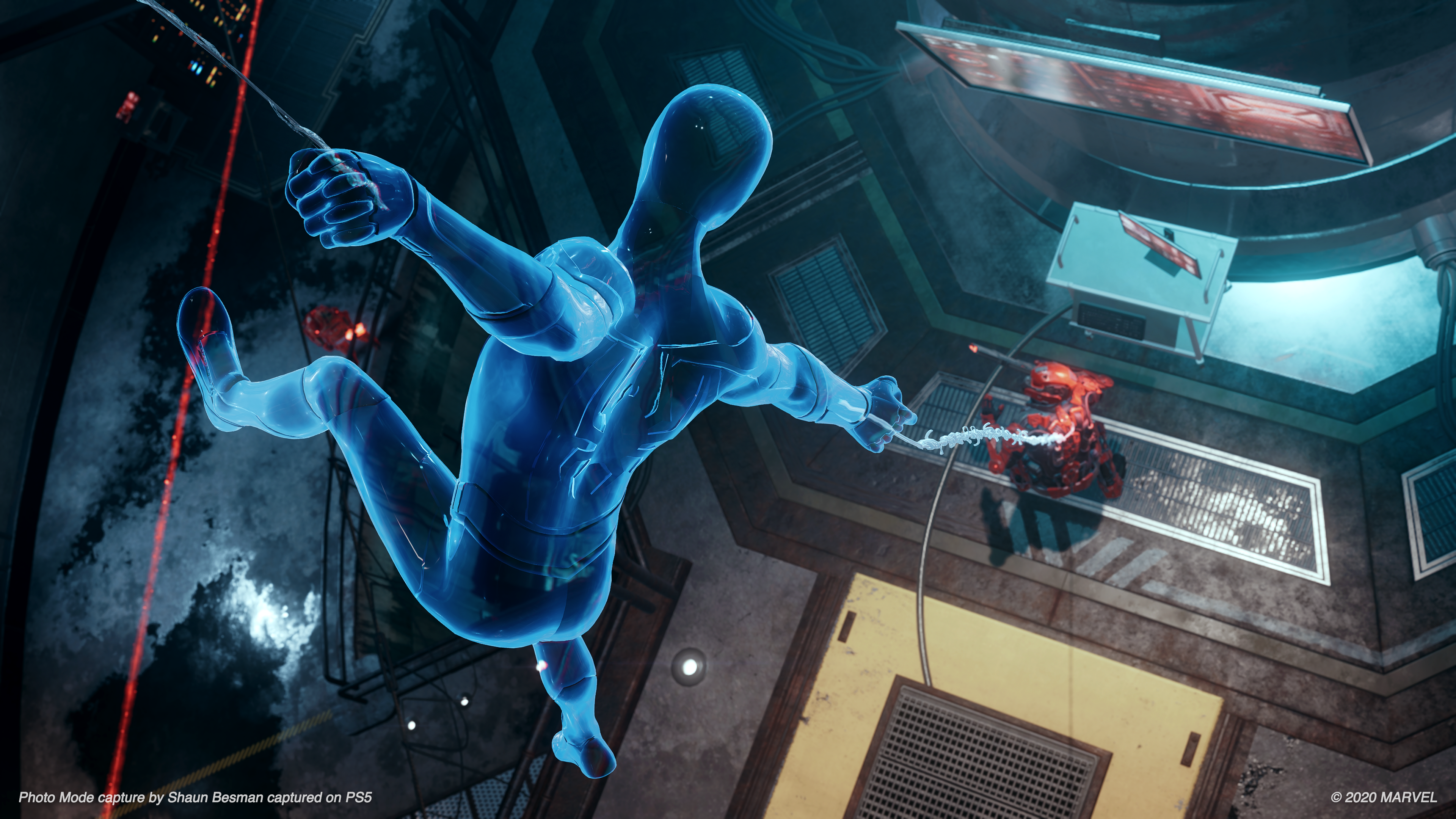Marvel’s Spider-Man Miles Morales is a coming of age story, an opportunity to focus on the “other Spider-Man,” and an excellent showcase of the PS5 in direct comparison with its popular PS4 predecessor. Every hero starts somewhere, and while Insomniac was content not to revisit Peter Parker’s origin story for the hundredth time, following up on Miles Morales becoming Spider-Man proves just the shot in the arm the franchise needs to stand apart.
One of the first things Miles Morales does is gets Peter Parker out of the picture, at least for the most part. His presence is still felt as a mentor to Miles, but the story gives what New York so kindly refers to as “the other Spider-Man” the great responsibility to protect the city himself while Peter is away. It’s something of a trial by fire for Miles, who worries he can’t live up to the Spider-Man legacy. Allowing Miles to stand center stage without Peter Parker also hogging the spotlight was the right call.
It’s also a deeply personal story, as much about Miles and his home in Harlem as it is about the superhero aspects of the character protecting all of New York City. This personal human element is something Insomniac nailed really well in Marvel’s Spider-Man and perhaps accomplishes even better in Miles Morales. In many ways it’s easy to compare it to the stellar Into the Spider-Verse film, which was clearly a strong point of influence for Insomniac in developing Miles Morales.
I don’t want to go too much deeper on the Miles’ storyline, because it’s best discovered alongside this superpowered kid from Harlem, but suffice to say it’s a powerful narrative less focused on the costume and more focused on the man beneath the mask. It’s a novel way to make a superhero game: allow gameplay to center on the powers and support the narrative with the person who wields those abilities. Miles is a special person too, an icon in Black representation by superheroes, and Insomniac treats this legacy with the respect, dignity, and representation it deserves.
Marvel’s Spider-Man Miles Morales Review – Thwip!
Spider-Man Miles Morales uses the original Marvel’s Spider-Man as a launching point for its gameplay, but also brings Miles’ unique Venom (the name for Miles’ bioelectricity) and Camouflage abilities to the forefront. Each of these adds new twists to gameplay that the original webhead didn’t have, including enemy variations to account for the increased capabilities of Harlem’s Spidey.
Venom is a powerful ability that allows Miles to charge up attacks with his bioelectricity, as well as coming into play during environmental encounters (used for things like overloading or draining generators). Venom energy builds up via moves in combat, but is balanced in a way that it can be used pretty consistently, if you’re fighting well. This wrinkle adds a lot of dimension to the combat that I didn’t even realize the original game was missing. Camouflage, on the other hand, brings a new facet to stealth encounters allowing for some additional options while trying to remain hidden, and even lets Miles disappear during combat if you need to catch your breath.
Traversal more or less matches what was established in Marvel’s Spider-Man, though Miles gets his own unique animations to clearly show he’s not just a Peter Parker clone. His animations all appear a bit more wild and uncontrolled, like a Spider-Man still in training, but also like a Spider-Man still having fun with his new powers. It’s a distinctive Miles flair that again helps set him apart from Peter Parker despite sharing the hero’s name. It’s also apparent in stealth encounters as Miles will teeter back from a perch upon stringing up an enemy.
Marvel’s Spider-Man Miles Morales Review – Brevity and Soul
One of my biggest criticisms with Marvel’s Spider-Man was how it failed to do much to change up the open-world formula, packed to the brim with collectibles to collect, enemy bases to liberate, and the general massive checklist of “stuff” to do that can feel a lot like padding. Miles Morales rebalances the open-world experience, pulling back on the number of enemy bases, adding more narrative meaning to the collectibles—which I won’t spoil here—and generally not making itself feel overly packed with the “extras” that can make a game feel bloated. In fact, I never reached the point of “checklist fatigue,” even as I got 100% across the game, earning all of the game’s various (and awesome) suits and completing each region of the city.
Miles Morales is a noticeably shorter game than Marvel’s Spider-Man, even in narrative, though that brevity allows every character, story beat, and moment throughout the game to land. It never felt packed too full of characters and storylines. Side content didn’t over-bloat and pull focus. Its pacing simply lets the soul of the experience burn bright no matter what you’re doing as Miles. And that soul is one of the biggest elements that sets Miles Morales apart from Marvel’s Spider-Man, while also keeping it directly in line with everything that first game set up.
And yet, for a more concise experience, Insomniac set up tantalizing incentives to revisit Miles’ story in New Game+. Certain mods, suits, upgrades, and abilities aren’t available until your second time through the game. It’s not just restarting to play again, but providing tweaks that make it feel meaningfully different to go through a second time. And with shorter length of the game, tapping that New Game+ option is going to be a lot easier to do.
Marvel’s Spider-Man Miles Morales Review – Does Whatever a PS5 Can
We played Miles Morales on the PS5 as part of our early console review, and it’s an incredible showcase of PS5-specific features. Insomniac used the haptic feedback in the DualSense controller to admirable effect throughout the game, from providing the visceral feeling of Miles’ Venom in combat to more subtle effects layered in quieter moments. The adaptive triggers make swinging through New York City feel like one might imagine this super ability would, albeit from the safety of your couch. There’s an increase in pressure at the end of thee trigger pull before it “pops” as you send your web flying, with a small vibration added to enhance the effect.
Ray tracing makes the game absolutely gorgeous in 4K, with natural reflections giving every surface in the game added dimensionality, a subtle but noticeable effect that enhances the immersion throughout the game. If you want this visual fidelity, however, you’ll have to settle for 30fps. There’s a performance mode that ups the frame rate to 60 fps, but the lack of ray tracing and other visual fidelity drops made the smoother motion not worth it to me. I tried both throughout, but ultimately settled on the 30 fps visual fidelity mode because it simply looked a lot better. 60fps is nice, but ray tracing is nicer.
Of course, it wouldn’t be a first-party Sony game without a robust photo mode to accompany it. Perhaps the biggest addition this time around is the ability to add up to three lighting points to the scene while also have some limited control over the global. Lighting effects can take some just alright shots to new heights, especially where the power of the PS5 is concerned.
Marvel’s Spider-Man Miles Morales is the perfect showcase of the PS5, espousing multiple enhancements to its last-gen predecessor while also feeling familiar. Even apart from its standing as a flagship PS5 launch title, Miles Morales is Insomniac perfecting the formula from the original game and offering an experience that is more concise, focused, and full of heart than the first.
Marvel’s Spider-Man Miles Morales review code provided by publisher. Reviewed on PS5. For more information on scoring, please read our Review Policy.
-
A focused and personal Miles Morales story
-
Into the Spider-Verse animation effect
-
Added abilities diversify combat
-
Rebalanced open world formula to eliminate "checklist fatigue"
-
Amazing demonstration of the PS5's capabilities
-
Some may not be happy giving up ray tracing for 60fps









